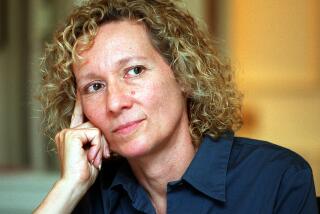Martyl Langsdorf dies at 96; artist created Doomsday Clock image
Martyl Langsdorf, the artist who created the widely known Doomsday Clock for the first cover of the Bulletin of Atomic Scientists, died March 26 at a rehabilitation facility near her home in suburban Chicago of complications from a lung infection. She was 96.
Since its introduction in 1947, the drawing of the Doomsday Clock has kept watch as international incidents flared. The clock is a symbol of the Nuclear Age, whose minute hand moves closer to midnight — and presumed annihilation — with each major immediate danger.
The clock hands can also move backward, if tensions cool.
The hand has moved only 20 times during the past 65 years. It currently stands at five minutes to midnight.
Langsdorf, who worked in various media including painting, printmaking, drawing, murals and stained-glass design, made the leap from the art world into the controversy over atomic bombs through her husband.
Alexander Langsdorf Jr. was a nuclear scientist from a prominent St. Louis family. During World War II, he helped develop the atomic bomb, then joined other scientists in trying to persuade President Truman not to drop it on Japan. He helped start the Bulletin of the Atomic Scientists, an advocacy group formed in 1945 by Manhattan Project scientists to warn the public of the dangers of nuclear weapons and power.
“She understood the deep anxiety of the scientists in 1947, and the urgency of preventing the spread or use of nuclear weapons,” said Kennette Benedict, executive director of the Bulletin since 2005. “With the clock design, she gave the world a symbol that is even more potent today.”
Martyl Suzanne Schweig was born March 16, 1917, into a St. Louis family that embraced the arts. Her father, Martin, owned what was the oldest photo studio in St. Louis and photographed famous people. Her mother, Aimee, was an accomplished artist who taught at the private Mary Institute.
Martyl learned to draw during Saturday morning art lessons at the St. Louis Art Museum. By age 11 she was considered a prodigy.
She graduated from Mary Institute and Washington University in St. Louis and married Langsdorf in 1942. His mother, Elsie Langsdorf, was the first St. Louis-area woman elected to the Missouri Legislature. His father, Alexander Langsdorf Sr., was dean for 40 years at Washington University’s Schools of Engineering and Architecture.
Before the couple moved to Chicago in 1943, her husband and a fellow scientist built a cyclotron at Washington University to secretly produce the first plutonium for the Manhattan Project.
She became internationally known for her abstract landscapes and had some 100 solo exhibitions during her long career, in addition to many group shows. Her works have been displayed in museums throughout the country.
The design of the Doomsday Clock, four dots and two lines, used a recognized object — a clock — and evoked the traditional imagery of the apocalypse (the cry at midnight) and the countdown to zero hour, or a military attack.
“It’s such an intuitively tension-building image,” graphic designer Michael Bierut, who updated Langsdorf’s design in 2007, told the Washington Post. “To be able to reduce something that complex to something so simple and memorable is really a feat of magic.”
When the Soviet Union tested its first nuclear weapon in 1949, the scientists who guided the Bulletin moved the hands four minutes closer to midnight.
“The scientists decided to use it imaginatively as a metaphor,” Bierut, who is on the Bulletin’s board of governors, told the Washington Post. “To wed this almost childish cliche to this fear of the annihilation of the Earth, that’s really remarkable.”
Langsdorf’s husband died in 1996. Her survivors include two daughters, Alexandra Shoemaker of Aptos, Calif., and Suzanne Langsdorf of Arlington, Va.; four grandchildren, two great-grandchildren and a brother.
More to Read
Start your day right
Sign up for Essential California for the L.A. Times biggest news, features and recommendations in your inbox six days a week.
You may occasionally receive promotional content from the Los Angeles Times.






